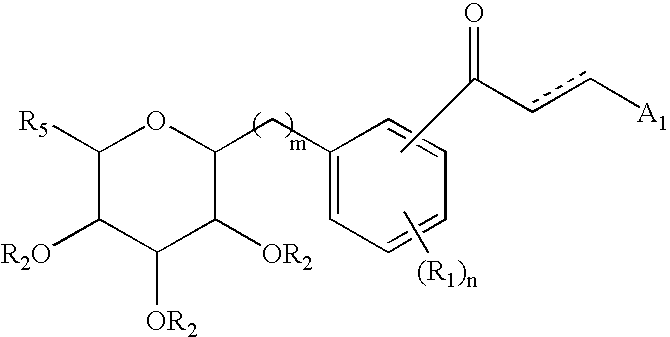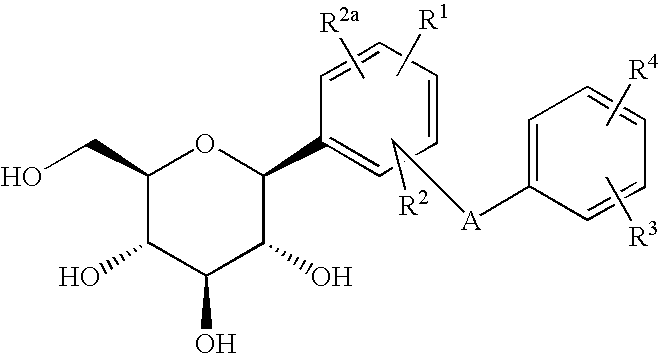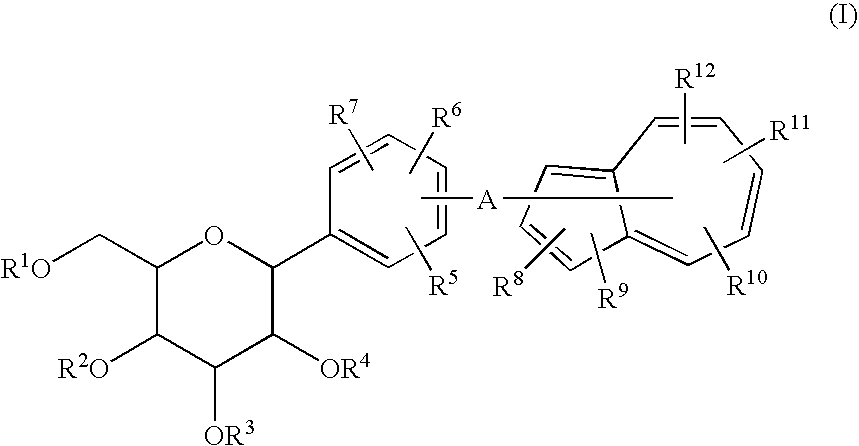Azulene derivatives and salts thereof
a technology of azulene and salt, applied in the field of azulene derivatives, can solve the problems of disappearing hypoglycemic effect, and achieve the effect of inhibiting the cotransporter of na+-glucos
- Summary
- Abstract
- Description
- Claims
- Application Information
AI Technical Summary
Benefits of technology
Problems solved by technology
Method used
Image
Examples
preparation example 1
[0041]A process of Preparation Example 1 comprises subjecting an azulene compound (1) to a Friedel-Crafts reaction followed by reduction to prepare a compound (2), reacting the compound (2) with a compound (3) by an addition reaction to prepare a compound (4), reducing the compound (4) to prepare a compound (I), and deprotecting the compound (I) to prepare a compound (I′), as shown in the following formula.
[0042]
wherein R1 to R12 and A are the same as above.
[0043]The Friedel-Crafts reaction is carried out in the presence of an appropriate Lewis acid, in the absence of a solvent, or in an appropriate solvent. Specific examples of the Lewis acid include aluminum chloride, boron trichloride, zinc chloride, vanadium chloride, ferric chloride, and stannic chloride. Specific examples of the solvent include ethers such as diethyl ether and tetrahydrofuran; haloalkyls such as chloroform, dichloromethane, and 1,2-dichloroethane; dimethylformamide; dimethylsulfoxide; and a mixture of these so...
preparation example 2
[0048]A process of Preparation Example 2 comprises reacting a compound (3) with a compound (5) to prepare a compound (6), reducing the compound (6) to prepare a compound (7), halogenating the compound (7) to prepare a compound (7′), reacting the compound (7′) with an azulene derivative (8) to prepare a compound (I), and deprotecting the compound (I) to prepare a compound (I′), as shown in the following scheme.
[0049]
wherein X represents a halogen, B(OR13)3, wherein R13 is H or a lower alkyl, or SnR143, wherein R14 is a lower alkyl.
[0050]The reaction of the compound (3) with the compound (5) is carried out in the same manner as in the reaction of the compound (2) with the compound (3) of Preparation Example 1.
[0051]The subsequent reduction reaction to prepare the compound (7) is carried out in the same manner as in the reduction reaction of the compound (4) of Preparation Example 1. The subsequent halogenation of the compound (7) to prepare the compound (7′) is carried out in the pres...
preparation example 3
[0056]A process of Preparation Example 3 comprises protecting an alcohol derivative (9), reacting the protected derivative (9) with a compound (3) to prepare a compound (10), reducing and deprotecting the compound (10) to prepare a compound (11), halogenating the compound (11) to prepare a compound (7′), reacting the compound (7′) with an azulene derivative (8) to prepare a compound (I), and deprotecting the compound (I) to prepare a compound (I′), as shown in the following scheme.
[0057]
wherein P represents a protective group, and X represents a halogen, B(R13)3, wherein R13 is H or a lower alkyl, or SnR143, wherein R14 is a lower alkyl.
[0058]The alcohol derivative (9) is protected by a suitable protective group such as a t-butyldimethylsilyl group, t-butyldiphenylsilyl group, and tetrahydropyranyl group according to a conventional method. The subsequent reaction with the compound (3) is carried out in the same manner as in the reaction of the compound (2) with the compound (3) of P...
PUM
| Property | Measurement | Unit |
|---|---|---|
| temperature | aaaaa | aaaaa |
| temperature | aaaaa | aaaaa |
| temperature | aaaaa | aaaaa |
Abstract
Description
Claims
Application Information
 Login to View More
Login to View More - R&D
- Intellectual Property
- Life Sciences
- Materials
- Tech Scout
- Unparalleled Data Quality
- Higher Quality Content
- 60% Fewer Hallucinations
Browse by: Latest US Patents, China's latest patents, Technical Efficacy Thesaurus, Application Domain, Technology Topic, Popular Technical Reports.
© 2025 PatSnap. All rights reserved.Legal|Privacy policy|Modern Slavery Act Transparency Statement|Sitemap|About US| Contact US: help@patsnap.com



